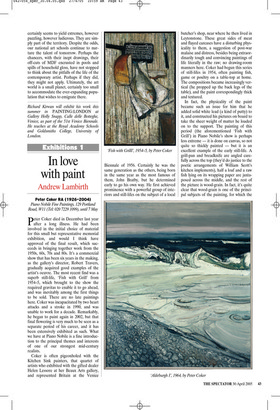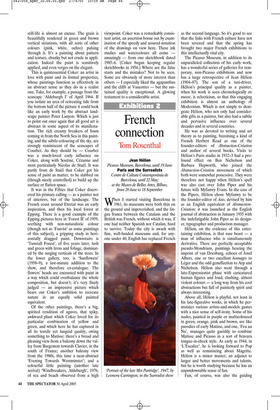In love with paint
Andrew Lambirth
Peter Coker RA (1926–2004) Piano Nobile Fine Paintings, 129 Portland Road, W11 (Tel: 020 7229 1099), until 7 May Peter Coker died in December last year after a long illness. He had been involved in the initial choice of material for this small but representative memorial exhibition, and would I think have approved of the final result, which succeeds in bringing together work from the 1950s, 60s, 70s and 80s. It’s a commercial show that has been six years in the making, as the gallery’s director, Robert Travers, gradually acquired good examples of the artist’s oeuvre. The most recent find was a superb still-life, ‘Fish with Grill’ from 1954–5, which brought to the show the required gravitas to enable it to go ahead, and was inevitably among the first things to be sold. There are no late paintings here. Coker was incapacitated by two heart attacks and a stroke in 1990, and was unable to work for a decade. Remarkably, he began to paint again in 2002, but that final flowering is very much to be seen as a separate period of his career, and it has been extensively exhibited as such. What we have at Piano Nobile is a fine introduction to the principal themes and interests of one of our strongest mid-century realists.
Coker is often pigeonholed with the Kitchen Sink painters, that quartet of artists who exhibited with the gifted dealer Helen Lessore at her Beaux Arts gallery, and represented Britain at the Venice Biennale of 1956. Certainly he was the same generation as the others, being born in the same year as the most famous of them, John Bratby, but he determined early to go his own way. He first achieved prominence with a powerful group of interiors and still-lifes on the subject of a local butcher’s shop, near where he then lived in Leytonstone. These great sides of meat and flayed carcases have a disturbing physicality to them, a suggestion of post-war malaise and distress, besides being extraordinarily tough and convincing paintings of life literally in the raw; no drawing-room manners here. Coker had begun this series of still-lifes in 1954, often painting fish, game or poultry on a table-top at home. The compositions became increasingly vertical (he propped up the back legs of the table), and the paint correspondingly thick and textured.
In fact, the physicality of the paint became such an issue for him that he added solid white lead (a kind of putty) to it, and constructed his pictures on board to take the sheer weight of matter he loaded on to the support. The painting of this period (the aforementioned ‘Fish with Grill’) in Piano Nobile’s show is perhaps less extreme — it is done on canvas, so not quite so thickly painted — but it is an excellent example of the early still-life. A grill-pan and breadknife are angled carefully across the top (they’d do justice to the poetic arrangements of William Scott’s kitchen implements), half a loaf and a raw fish lying on its wrapping paper are juxtaposed across the middle, and the rest of the picture is wood-grain. In fact, it’s quite clear that wood-grain is one of the principal subjects of the painting, for which the still-life is almost an excuse. The grain is beautifully rendered in green and brown vertical striations, with all sorts of other colours (pink, white, ochre) pulsing through it. It’s a painting about pattern and texture, chunky but not crude in application. Indeed the paint is sensitively applied, and even verges on the elegant.
This is quintessential Coker: an artist in love with paint and its formal properties, whose paintings function as effectively in an abstract sense as they do in a realist one. Take, for example, a passage from the seascape ‘Aldeburgh I’ of April 1964. If you isolate an area of retreating tide from the bottom half of the picture it could look like an early work by the abstract landscape painter Peter Lanyon. Which is just to point out once again that all good art is abstract in some aspect of its manifestation. The rich creamy breakers of foam coming in from the North Sea in this painting, and the subtle colouring of the sky, are strongly reminiscent of the seascapes of Courbet. As they should be — Courbet was a much-loved early influence on Coker, along with Soutine, Cézanne and most particularly Nicolas de Staël. It was partly from de Staël that Coker got his sense of paint as matter, to be slabbed on (though nicely controlled) to build up the surface or flatten space.
It was in the Fifties that Coker discovered his primary calling — as a painter not of interiors, but of the landscape. The French coast around Etretat was an early inspiration, and then his local forest at Epping. There is a good example of the Epping pictures here in ‘Forest II’ of 1959, seething with non-naturalistic colour (though not as ‘Fauvist’ as some paintings of this subject), a gripping study in horizontally dragged paint. Downstairs is ‘Tunstall Forest’, of five years later, lush and green with ferns and foliage, dominated by the surging verticals of the trees. In the lower gallery, too, is ‘Sunflowers’ (1958–9), a last-minute addition to the show, and therefore ex-catalogue. The flowers’ heads are encrusted with paint in a way which could overbalance the whole composition, but doesn’t; it’s very finely judged — an impressive picture which bears out Coker’s ambition to recreate nature in an equally solid painted equivalent.
Of the other paintings, there’s a big, spirited rendition of agaves, that spiky, awkward plant which Coker loved for its particular combination of yellow and green, and which here he has captured in all its tensile yet languid quality, owing something to Matisse; there’s a broad and pleasing view from a balcony down the valley from Bargemon towards Clavier, in the south of France; another balcony view from the 1980s, this time a near-abstract ‘Evening Towards Westminster’; and a colourful little painting (another late arrival) ‘Windbreakers, Aldeburgh’, 1976, of sea and beach observed from a high viewpoint. Coker was a remarkably consistent artist, an assertion borne out by examination of the speedy and assured notation of the drawings on view here. These ink studies and watercolours all come amazingly — from one sketchbook dated 1985–6. (Coker began keeping regular sketchbooks in 1956.) Where are the false starts and the mistakes? Not to be seen. Some are obviously of more interest than others — I especially liked the agapanthus and the cliffs at Vaucottes — but the sustained quality is exceptional. A glowing testament to a considerable artist.





















































 Previous page
Previous page